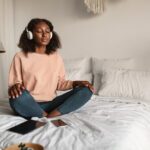Many people try to address anxiety or depression separately, but the two conditions often co-occur. The reality is that these disorders tend to hang together, and it’s more common than you think to experience both depression and anxiety at the same time.
If you’re experiencing both conditions at once, we’ll show you how to recognize the signs and symptoms and, even more importantly, how to treat them.
Many people try to address anxiety or depression separately, but the two conditions often co-occur. The reality is that these disorders tend to hang together, and it’s more common than you think to experience both depression and anxiety at the same time.
If you’re experiencing both conditions at once, we’ll show you how to recognize the signs and symptoms and, even more importantly, how to treat them.
The strong link between anxiety and depression
Over 40% of those diagnosed with depression also had one or more anxiety disorders within the same 12-month period. Nearly half of those with anxiety disorders will also experience major depression at some point in their lives.
Plus, anxiety disorders are the single most significant risk factor for developing depression. In cases where depression and anxiety exist simultaneously within a person, it’s most common for anxiety to precede depression.
Approximately 85% of people battling depression also experience some significant symptoms of anxiety. Similarly, nearly 90% of patients with anxiety also experience some significant emotional and physical symptoms of depression.
What causes anxiety and depression?
Factors that can influence the development of both anxiety and depression include:
- Shared genetic risk factors
- Personality, especially the tendency towards negative feelings and self-doubt
- Early adversity such as trauma, neglect, or toxic stress
- Neurobiology, specifically in the parts of the brain responsible for emotional regulation, cognitive control, and executive function
Even if you have all of these influencing factors, you won’t necessarily experience depression and anxiety. These elements simply increase the likelihood of their occurrence.
Here’s the good news: you can target any of these risk factors through prevention.
For example, if you know anxiety, depression, or both run in your family, you may choose to practice preventative mental health behaviors such as exercise, mindfulness, and behavioral strategies like CBT.
You may also be on the lookout for the early signs of anxiety and depression so you can seek prompt treatment.
Symptoms of anxiety and depression
There isn’t a clinical diagnosis in the Diagnostic and Statistical Manual (DSM-5) for depression and anxiety. From a medical perspective, people who experience these conditions simultaneously have both a diagnosable anxiety disorder and a diagnosable depressive disorder.
If you start to compare depression vs. anxiety symptoms, you’ll notice that there’s significant overlap. The table below shows distinct symptoms of each disorder, as well as overlapping symptoms common to both. Some people have started referring to the simultaneous experience of anxiety and depression as “agitated depression.”
Anxiety-depression overlap
| Generalized Anxiety Disorder | Both (“agitated depression”) | Depression |
| -Excessive worry -Feeling restless -Muscle tension -Racing heart -Panic | -Fatigue or exhaustion -Difficulty sleeping -Difficulty concentrating -Irritable mood -Repetitive negative thinking -Difficulty regulating emotions -Impaired functioning in critical areas of life | -Feeling down or depressed -Diminished interest in activities you once enjoyed -Changes in weight and appetite -Recurrent thoughts of death |
Most of us experience some of these symptoms some of the time. For example, it’s common to worry, feel tense, or be down. That’s part of being human and responding to the stressors we face in life.
The difference with clinical disorders like anxiety or depression is that these experiences significantly inhibit your capacity to perform at work or school, show up in relationships, and engage in leisure.
Treating anxiety & depression
Having anxiety or depression can limit your capacity to participate in life. And battling both issues at the same time can feel incredibly overwhelming and exhausting.
You might feel extremely tired but find that you can’t put down certain thought spirals or stop catastrophic thinking. Maybe you feel so exhausted and caught by the whole experience that you just have no idea what to do next.
Recognizing just how often these disorders co-occur urges us to consider tools and approaches that target them simultaneously, effectively helping with anxiety and depression at the same time.
When it comes to caring for your mental health, it’s crucial to recognize that you have choices.
These are a mix of professional treatments, lifestyle modifications, and self-management tools proven to help with depression and anxiety symptoms.
1. Move in any way that feels good.
We know that physical activity is really good for mental health. It can help prevent anxiety and depression, manage symptoms, and manage your overall mood and stress levels. For co-morbid depression and anxiety, a recent study suggests that exercise is most effective when combined with medication.
The ideal dose of exercise is 30 – 45 minutes, 3 – 5 times per week, at moderate or high intensity. But don’t let this ideal get in the way of being active. Even for people who aren’t experiencing mental health conditions, building an exercise habit takes time and effort.
Set small, achievable goals to begin. Choose any form of movement that feels good. Even 5 minutes a day, or dancing to a single Lady Gaga song, is a commendable place to start.
2. Protect your sleep.
Sleep disturbances like insomnia are common to both depression and anxiety. Persistent lack of sleep tends to amplify anxiety, negative thinking, and emotional vulnerability.
On the other hand, getting a good night’s sleep can consistently alleviate the co-occurring depression and anxiety symptoms.
Experts recommend beginning with “sleep hygiene” habits to protect your rest. These include going to bed and waking up at the same time each day, using your bedroom for sleep and sex only, and avoiding technology at bedtime.
If you find your mind won’t stop talking to you, try a relaxation technique such as progressive muscle relaxation (PMR) or some relaxing exercises.
3. Practice emotional awareness.
If you have both mental health conditions, you’re probably no stranger to dark, stormy, complex emotions. In the moment, you may fear they will last forever.
But the reality is that, like waves in the ocean, they arise, peak, crash, and recede. Though we may not want to experience these kinds of feelings, there’s a psychological cost to denying them inwardly.
It may seem counterintuitive, but denying negative emotions actually makes them stronger. Seeing them as waves that will pass can help you accept and tolerate the distress that comes your way.
4. Address negative thinking.
Negative thinking is one of the core experiences that’s common to all kinds of anxiety and depression. Even though these negative thought patterns may persist, you don’t have to believe what they’re telling you.
One common strategy is to push the thoughts away, which tends to amplify their power. And the other tendency is to let that destructive thinking run the whole show. Instead of these pitfalls, see if you can pause and acknowledge the thought for what it is.
Labeling is one tool that helps take power out of negative thoughts. If your thinking is criticizing you, try to take a quiet moment to notice and name it. You can greet that critical voice deliberately. Maybe you say, “hello, inner critic— I see you.” Doing this doesn’t mean that negative self-talk won’t disappear, but they’ll likely lose some of their power.
You may also want to work with a trained clinician to learn cognitive behavioral therapy techniques like cognitive restructuring to help reframe negative thinking.
5. Engage in pleasure.
Who said taking care of your mental health can’t be fun? One tool for mood regulation is to identify pleasurable activities and schedule them into your day.
It may sound too simple to be true. But the truth is that with mental health issues, or even just the busyness of life, it’s easy to let self-care and fun fall by the wayside. So bringing it back in requires focused effort.
To begin, identify 5 – 10 manageable activities that sound enjoyable. This activity might be reading, watching funny videos, taking a bath, cuddling your dog, watching a show, taking a walk, using a massage roller, smelling lavender, or anything else you like to do. Then schedule at least 10 minutes a day of pleasure, and do your best to prioritize it.
6. Talk it out.
Psychotherapy or talk therapy can be helpful for both conditions. Rather than focusing on a specific diagnosis, therapy is personalized to you and your needs.
Two effective approaches for both mental health issues are acceptance and commitment therapy (ACT) and cognitive behavioral therapy (CBT).
Some forms of CBT focus on a single condition, so check with your prospective therapist to ensure they can help you address both anxiety and depression symptoms simultaneously. More important than the specific modality is finding someone who’s the right fit.
7. Get medical support.
Medication can target both conditions simultaneously. Start by reaching out to a medical provider for an evaluation.
If an antidepressant or some other prescription medication is the right approach, ongoing care is ideal for finding the proper med, identifying the appropriate dosage, and monitoring side effects.
Finding affordable medical care can be difficult, but Lemonaid is here to make it easy. Visit Lemonaid to schedule an online consultation and talk to a medical professional about how to treat these conditions.
No one would wish for mental health issues. That being said, many people find that the skills they learn and practice to get relief from these conditions continue to support their well-being and personal growth long after the symptoms subside.
Takeaway
- It’s very common for depression and anxiety to occur in the same person.
- While they’re distinct conditions, anxiety and depression have many overlapping symptoms.
- When it comes to helping with depression and anxiety, medication and psychotherapy can address both simultaneously.
- Lifestyle habits can also be an effective way to treat the symptoms of both conditions.











